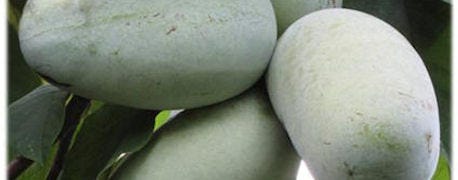October 4, 2012

Imagine a fruit that is native to Michigan yet looks and tastes as if it came from the tropics, is relatively disease- and pest-free, and contains high nutritional value. It sounds like a subject plucked from the pages of a novel, but the pawpaw is far from fiction.
Michigan State University AgBioResearch plant pathologist Dennis Fulbright has been researching the little-known fruit for the past decade. Although he believes that the pawpaw has untapped market potential, especially as a Michigan processed product, he realizes he faces quite a challenge.

The pawpaw is the largest fruit native to the United States.
"It's like trying to introduce an egg to an eggless society," says Fulbright, a professor in the MSU Department of Plant, Soil and Microbial Sciences. "Basically, the obstacle with the pawpaw is that there is no supply chain. Crops without supply chains or ones that already have a supply chain are very difficult to work with. It's hard either to establish the chain or break into it."
Weighing roughly a pound each, the fruit is the largest native to the United States. Although it's been called the "Michigan banana," the pawpaw is actually related to the tropical custard apple family and is the only temperate member of this tropical family of trees. Indigenous to eastern North America, the pawpaw grows as far north as Michigan and southern Ontario. The flavor is often described as a blend of mango, banana and melon, but Fulbright likens it to a mild egg custard.
Despite high-profile fans in history such as Thomas Jefferson, who planted the trees at Monticello, and explorers Lewis and Clark, who chronicled consumption of the fruit on their expeditions, the pawpaw failed to achieve mass appeal. In fact, Fulbright refers to it as an "orphan crop" because of society's general lack of interest in it over the years.
One major drawback is the fruit's short window of ripeness – only a couple of weeks, usually in late September and early October. Taste the fruit outside that timeframe, and chances are that the consumer will never try it again, Fulbright says.
~~~PAGE_BREAK_HERE~~~"It's certainly a conundrum," says Fulbright, referring to the timing issue. "Pick them too early and they're astringent and you can't eat them. Then they start tasting pretty good, but pretty mild, as they approach ripeness. Then you hit that perfect time, and you realize you've got the pawpaw at its finest. Then suddenly, they get too strong. It's too much flavor, but that's when the bakery wants them because the flavor fuses best with the other ingredients. Unfortunately, you can't seem to stop the maturing process with refrigeration."
Fulbright believes that freezing the ripe fruit is perhaps the best opportunity for the pawpaw to obtain commercial viability. With this in mind, he is focused on finding machinery that can easily remove the skin and seeds, and puree the juicy, yellow flesh. The frozen product could then be used in various ways with an extended shelf life.
Although you won't find a pawpaw in the grocery store, chefs and the gourmet market have recently shown interest in the fruit, churning out pawpaw jellies, ice creams and breads. Earthy Delights in DeWitt, is now distributing some of the Michigan-grown fruit as a fresh product and also carries a pawpaw spiceberry jam.
A distinct selling point is the high nutritional value – a pawpaw contains three times as much vitamin C as an apple and has higher protein and fat content than apples, bananas or oranges.
"Without question, it's a fruit we should be eating, but someone has to grow it and get it into the marketplace," Fulbright says. "Michigan is working to do just that."
One such example is Marc Boone, who owns 2 acres and about 300 pawpaw trees 10 miles west of Ann Arbor. A self-described hobbyist grower of many types of fruits, Boone planted the pawpaw trees in 1986. Over the years, he found himself giving the fruit away to co-workers, friends and family. It was only within the past few years that he has found a market for some.
Boone is selling the fruit to Zingerman's Creamery, which is using it to make a seasonal pawpaw gelato. He believes there is market potential for the pawpaw but one a grower must pursue.
"For me, it was my aunt who pestered me until I finally approached Zingerman's," Boone says. "She thought it would be a good fit, and she was right."
~~~PAGE_BREAK_HERE~~~The Zingerman-produced gelato is now also being sold at Greenfield Village in Detroit.
Field trials at the MSU Rogers Reserve in Jackson are being conducted by Fulbright and farm manager Mario Mandujano. The cultivars are from Neal Peterson, a plant scientist who has been growing and studying the fruit for the past two decades in West Virginia. Fulbright says that many of Peterson's patented cultivars, including the Potomac and Shenandoah, grow well in Michigan.
Another influential pawpaw breeder was the late Corwin Davis, who hailed from Belleview, Mich. He had considerable success introducing varietals particularly conducive to growing in the Great Lakes region, including Davis, Prolific and Sunflower.
"Taylor and Tay 2, named after horticulture professor emeritus Lee Taylor at MSU, are also all very good for propagation here in Michigan," Fulbright adds.
For anyone considering planting a pawpaw, Fulbright offers some advice: be sure to get a cultivar, not a seedling.
"You'll find that not many nurseries carry pawpaw trees, but once you find one, I suggest you spend up to $40 on a grafted tree rather than $10 on a seedling," Fulbright says. "If you go for the seedling, I can pretty much assure that you're going to be disappointed -- it takes as long as 100 days for the seed to germinate once it's planted in the spring, and about 5 or more years to mature and begin producing flowers and the fruit. Grafted trees should begin bearing flowers and, therefore, fruit much sooner."
You May Also Like




